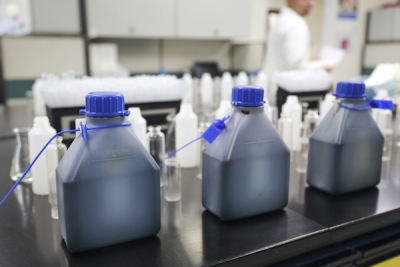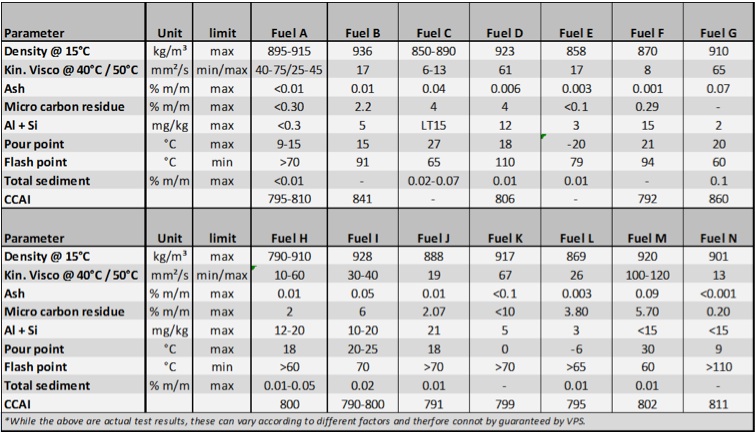The quality of 'hybrid'/ECA-compliant fuels - is more choice necessarily a good thing?

Since the introduction of new ECA fuels (NEFs) in the market end of 2014, the increase in number and variety has been simply impressive.
Over 20 products from different origins with and varying in quality characteristics, yet with the apparent common element of the maximum Sulphur (S) content of 0.10%. So is having all these choices necessarily a good thing?
As said, the current list consists of more than 20 products with qualities that vary according to their origin. The NEFs are comprised of various products from hydrocracker cycle oils, vacuum gas oils, (marine) diesel oils and light residuals and may differ significantly in their individual characteristics (see below typical values of part of the different products currently available).

When classified to the closest ISO 8217:2010/12 specification, the majority of these NEFs typically range from DMB (via RMA10 and RMB30) to RMD80. The majority of NEFs consists of RMD80.
The way that NEFs are produced provides a basic understanding of their overall properties and quality. Products from hydrocrackers for example, are already known units used at refinery and are frequently used to upgrade difficult distillate streams. Desired characteristics are that the product has no aromatics, very good ignition and combustion properties and yet, has a high viscosity relative to regular marine gas oil (MGO) or marine diesel oil (MDO), preventing issues with leaking fuel pumps and a very high flash point.
The undesired characteristics are that they may contain aliphatic material which presents potentially serious handling issues, when for instance blended/mixed with cracked residue containing fuels during change over or loading. Apart from this, they can be quite waxy so (some) heating is required to maintain the product in a liquid state for storage and transportation purposes.
Some of these products in the form of light residuals are made from blending with cracked components and this is clearly reflected on their typical specifications of having a higher Micro Carbon Residue (MCR) content and the possible presence of Aluminium & Silicon (Al + Si) which requires on-board treatment via settling and centrifuging. Due to the variety of NEFs with their different quality characteristics, handling them comes with challenges that relate to stability, compatibility, cold flow properties and gummy/varnish/resin like materials that might form during consumption.
Of these challenges, stability is the tendency of certain fuel properties in the unmixed fuel to change over time. It is known that higher temperatures can accelerate the destabilization process. In residual fuels it is affected by asphaltenic stability while in distillate fuels it is affected by oxidation stability. Long term storage may thus present some additional challenges.
Compatibility relates to any unstable mixture like for instance, when a residual is mixed with a NEF or, a distillate mixed with the light residual type NEF or when two NEFs are mixed. The risk of problems associated with compatibility increases even when one or both fuels contain thermally cracked residues.
The CIMAC (International Council on Combustion Engines) guidelines state that ISO 8217 limits the cold flow properties of a fuel by setting a limit on the pour point. The bunker industry only focuses on the pour point in order to meet specifications. However, given that wax crystals already starts to form at temperatures above the pour point, it can be challenging to handle fuels in colder climates that meet the pour point but have high cloud points. The wax crystals may rapidly block filters leading to a reduction in engine output or even total black out due to total fuel starvation.
Knowing only the pour point of a fuel is therefore not enough to evaluate the properties of distillate fuel and some of the NEFs as there is no correlation between pour point and/cloud point and cold filter plugging point, the other two parameters of cold flow properties.
Normally residual fuels requires heating while distillates and NEFs may not necessarily be stored in heated tanks due to their low viscosity. It must be noted however, that some of the NEFs may already have a pour point inhibitor added meaning that the formation of wax crystals might occur at a different temperature. Pour point inhibitors slow down the process of wax crystal formation. Fuel purchasers are therefore advised to carefully consider seasons and operational patterns, and specify the required cold flow properties (through cloud point and cold filter plugging point) when ordering distillates.
Straight-run gas oil based NEFs from the atmospheric distiller are very stable as they only contain very small amounts of unsaturated hydrocarbons. However, with cycle oils and gas oil streams from thermal conversion units such as cat crackers, vis-breakers or cookers, the levels of unsaturated hydrocarbons is very high making them very unstable. In combination with oxygen compounds that are in ample supply (air), these unsaturated hydrocarbons potentially form a whole range of materials that generally are not very diesel engine friendly. These materials manifest themselves as gummy/varnish/resin like materials that can coat fuel pump plungers and injector needles, causing them to jam in a worst case scenario lead to fuel starvation.
From the quality challenges and issues discussed above, it is obvious that with multiple options, ship operators have to be very vigilant about the use of different NEFs by giving attention to their quality characteristic/properties. Routine analysis of bunker samples obtained from the physical supplies and monitoring supplier performance in the relevant ports around the world are of paramount importance in this process. The vessel’s crew should report and record on-board fuel performance and all involved must improve their fuel management capabilities in order to get the optimal value from every aspect of fuel-related operations. Training should therefore definitely play a role. As the fuel management partner of choice with over 30 years of experience and the largest fuel quality database, VPS can provide tailormade advice on fuel handling for optimal performance and efficiency.
HEADLINES
- Do shipping markets want Biden or Trump for the win?
- All 18 crew safe after fire on Japanese-owned tanker off Singapore
- Singapore launching $44m co-investment initiative for maritime tech start-ups
- Cosco debuts Global Shipping Industry Chain Cooperation Initiative
- US warns of more shipping sanctions
- China continues seaport consolidation as Dalian offer goes unconditional